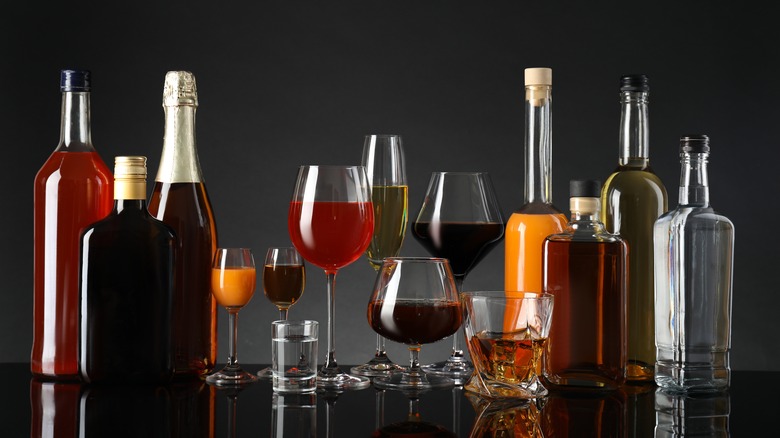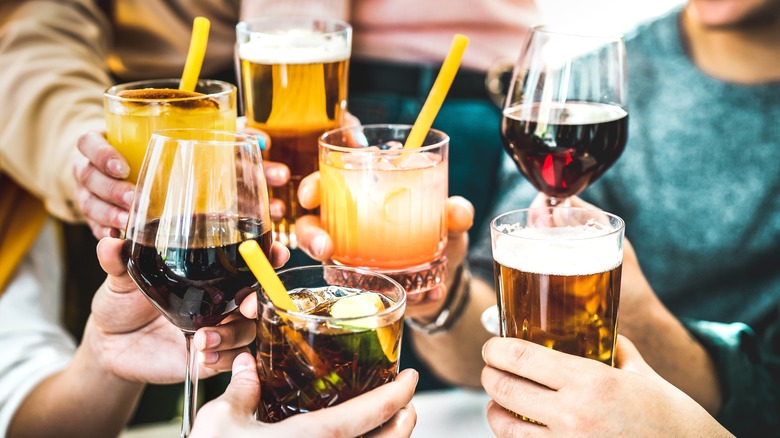The Main Reason We Have Standard Alcoholic Drink Measurements
All of the numbers associated with various alcoholic drinks can get confusing. There's proof and alcohol by volume (ABV), and then there's all different sizes and measurements of wine, beer, spirits ... it's a lot to keep track of. You've probably know that cocktails that sail past the 40% ABV mark are considered very strong, but let's talk about standard drink measurements. These are the serving sizes for categories of alcohol including the aforementioned wine, beer, and spirits. So why do we have them, and what do they actually mean?
The measurements for standard drinks vary greatly between different types, and that's because it's basically the amount of each beverage that contains 0.6 ounces of pure alcohol. But why this amount? In a nutshell, it's because that's how much alcohol the body can process in an hour ... more or less. There are a number of variables that can change that, such as a person's liver size. But the idea behind standard drink sizes isn't that they're an absolute — it's that they should be used as guidelines. These measurements are an easy way to keep track of your alcohol consumption and gauge how much your body is capable of processing.
Standardized drink measurements are a handy tool for measuring consumption
First, let's do a quick refresher on what the standardized drink measurements are. The general guidelines state that one standard drink equals one 12-ounce beer (at 5%), 8 to 10 ounces of 7% malt liquor, 5 ounces of 12% wine, 3 to 4 ounces of 17% fortified wine, 2 to 3 ounces of a 24% cordial, or one shot (which is equal to 1.5 ounces) of 40% (or 80-proof) liquor. You'll notice that works out to our .6 ounces of pure liquor, give or take. It's also important to note that while that's often a standard serving size (in many American beer cans), it's not always the case.
The idea is that standard serving sizes allow consumers to keep track of how much they've had to drink in a certain time span. Generally speaking — and we'll talk about some of the variables — that .6-ounce measurement of pure alcohol is what most human bodies can process over the course of an hour. That happens in a few ways: The liver does most of the work, but some also passes through your system and leaves via sweat, breath, and urine.
You've probably heard all the claims, like the one that drinking coffee could help you deal with a hangover. Unfortunately, it can't. Also, drink more than those standardized amounts and the alcohol starts to build up in your bloodstream to raise your blood alcohol content (BAC) and make you intoxicated.
There are some variables to consider
Although standard drink sizes themselves are pretty straightforward, there are some things to keep in mind — starting with the fact that you can't just go by sizes and be done with it. Take beer. Order your standard Guinness, and that's 4.2% alcohol. However, if you're fortunate enough to be vacationing in any of Europe's best beer destinations, you might opt to try a Belgian beer. Then you might find yourself with a single beer that's 9% alcohol, 12%, and sometimes even higher. Since a standard drink measurement comes with the caveat that it's 5% ABV, stronger beers can impact you very, very differently. When an alcohol is overproof, the quantities you're keeping in mind might no longer matter.
There are also factors that influence every individual's ability to process alcohol, and these, too, can make your experiences a little different. An enzyme called dehydrogenase aids in the processing of alcohol, so the amount of this enzyme produced can influence your body's efficiency. Hormone levels, dehydration, and whether or not you've eaten food recently or if you're taking any medications can all make you process alcohol faster or slower. Surprisingly, it's been found that the time of day also impacts how efficiently we process alcohol. Bottom line? Drink measurements are guidelines.


